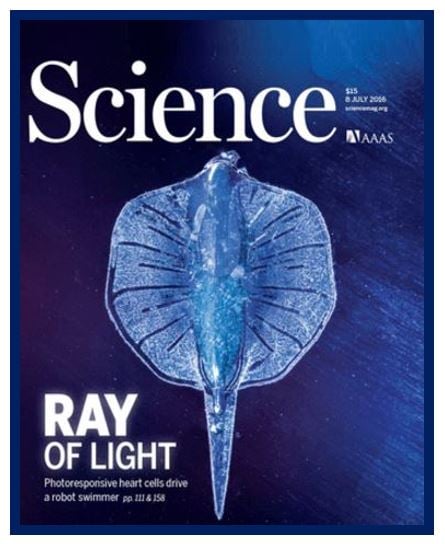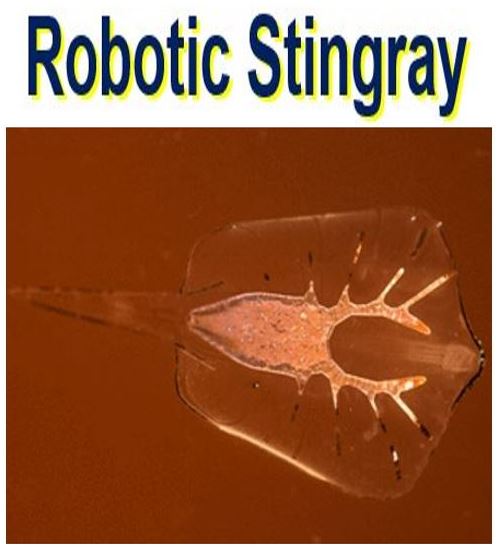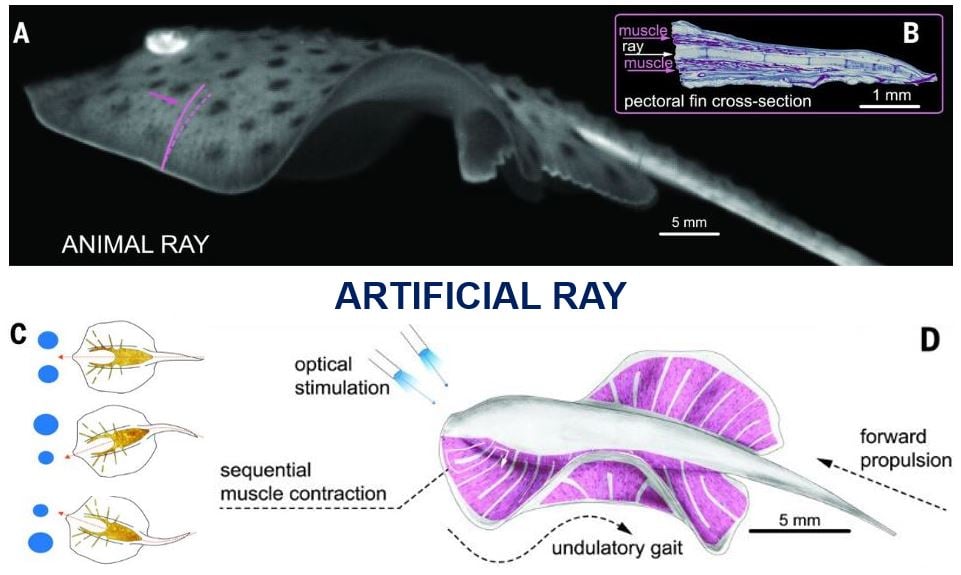A stingray robot made with rat heart cells that are sensitive to light has been created by an international team of researchers. The scientists, from the United States and South Korea, explained in the academic journal Science that the robot is guided by the photosensitive heart cells.
Team leader, Prof Kevin Kit Parker, Tarr Family Professor of Bioengineering and Applied Physics at Harvard University’s John A. Paulson School of Engineering and Applied Sciences, and colleagues said that their work exhibits a new method for building bio-inspired robots with tissue engineering technology.
 The stingray robot made the front cover of the latest issue of Science. The 16-mm-long ray is an amazing assemblage of metal, organic muscle tissue, and clear polymer. It ‘swims’ in response to a pulsing light. (Image: science.sciencemag.org)
The stingray robot made the front cover of the latest issue of Science. The 16-mm-long ray is an amazing assemblage of metal, organic muscle tissue, and clear polymer. It ‘swims’ in response to a pulsing light. (Image: science.sciencemag.org)
Batoidea, a superorder of cartilaginous fishes that include stingrays, are distinguished by their long, wing-like fins that extend from their heads, as well as their flat bodies.
Stingray fins move in energy-efficient waves that emulate from the fin’s front to the back – they move in a way that makes batoids move gracefully through water.
Creating a stingray robot in the lab
Lead author, Sung-Jin Park, a Research Associate in Bioengineering in the Wyss Institute, Harvard’s John A. Paulson School of Engineering and Applied Sciences, et al set out to create a miniature, soft-tissue robot with similar qualities and efficiency.
The scientists created neutrally-charged gold skeletons that mimic the shape of a stingray. The skeleton was overlaid with a thin layer of elastic polymer. They strategically aligned rat cardiomyocytes (cardiac muscle cells) along the top of the robotic stingray.
 One of the first images of the shoot shows a floating robotic ray. (Image: science.sciencemag.org. Credit: Ken Richardson)
One of the first images of the shoot shows a floating robotic ray. (Image: science.sciencemag.org. Credit: Ken Richardson)
When stimulated, the heart muscle cells contract the fins downward. As stimulating the fins to turn upwards would require a second layer of heart muscles, the scientists instead designed the gold skeleton in a specific shape, one that stores some downward energy, which is later released as the cardiomyocytes relax, allowing the fins to rise.
The heart muscle cells were genetically engineered to respond to light cues so that the scientists could control the robot’s movements using light pulses.
The robot can turn to the left or right when exposed to asymmetrical pulses of light, the researchers demonstrated. Its speed can be controlled with different frequencies of light, as one can see in a series of videos.
The stingray-like robot can be guided through a basic underwater obstacle course. It weighs just 10 grams (0.352 ounces), is 16 millimetres (0.629 inches) long, and contains approximately 200,000 cardiomyocytes.
 (A) A live Little skate swimming and (B) its musculoskeletal structure. (C and D) The tissue-engineered ray. (Image: science.sciencemag.org)
(A) A live Little skate swimming and (B) its musculoskeletal structure. (C and D) The tissue-engineered ray. (Image: science.sciencemag.org)
In an Abstract that preceded the main paper in Science, the researchers wrote:
“Optogenetics allows for phototactic guidance, steering, and turning maneuvers. Optical stimulation induced sequential muscle activation via serpentine-patterned muscle circuits, leading to coordinated undulatory swimming.”
“The speed and direction of the ray was controlled by modulating light frequency and by independently eliciting right and left fins, allowing the biohybrid machine to maneuver through an obstacle course.”
This robotic stingray could represent the next step in bioengineering: https://t.co/4JUu4IazAu
— Science Magazine (@sciencemagazine) July 8, 2016
Citation: “Phototactic guidance of a tissue-engineered soft-robotic ray,” Sung-Jin Park, Mattia Gazzola, Kyung Soo Park, Shirley Park, Valentina Di Santo, Erin L. Blevins, Johan U. Lind, Patrick H. Campbell, Stephanie Dauth, Andrew K. Capulli, Francesco S. Pasqualini, Seungkuk Ahn, Alexander Cho, Hongyan Yuan, Ben M. Maoz, Ragu Vijaykumar, Jeong-Woo Choi, Karl Deisseroth, George V. Lauder, L. Mahadevan and Kevin Kit Parker. Science. 08 Jul 2016: Vol. 353, Issue 6295, pp. 158-162. DOI: 10.1126/science.aaf4292.
Video – Robotic Stingray part animal part machine
This Science Magazine video explains what the robotic stingray is, how it is made and how it moves.
